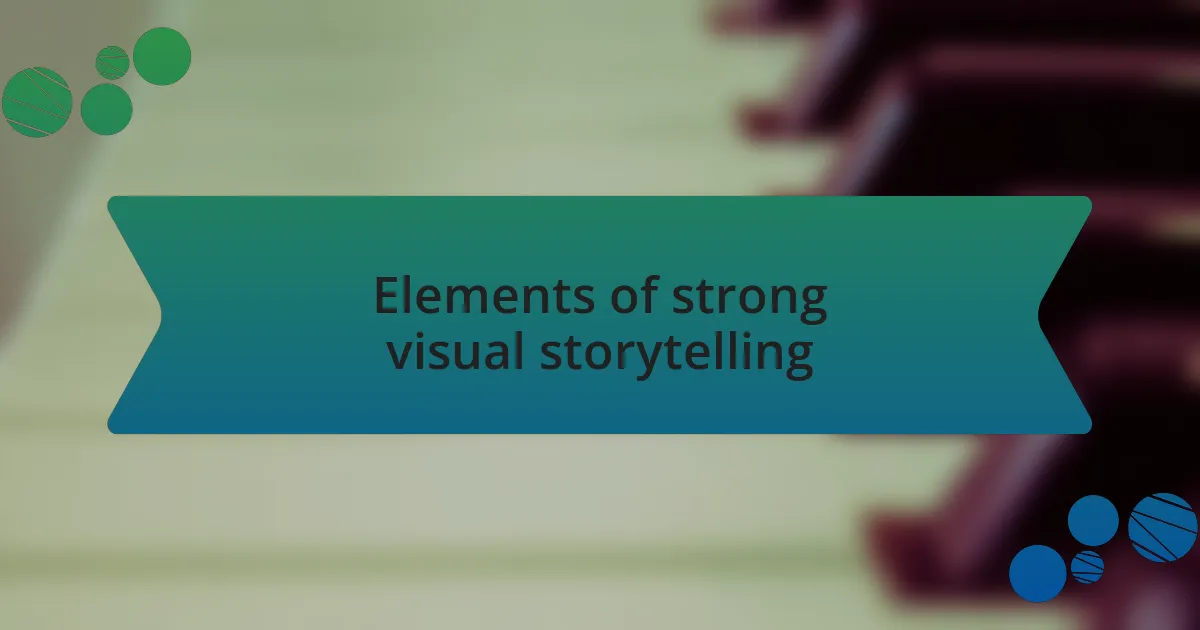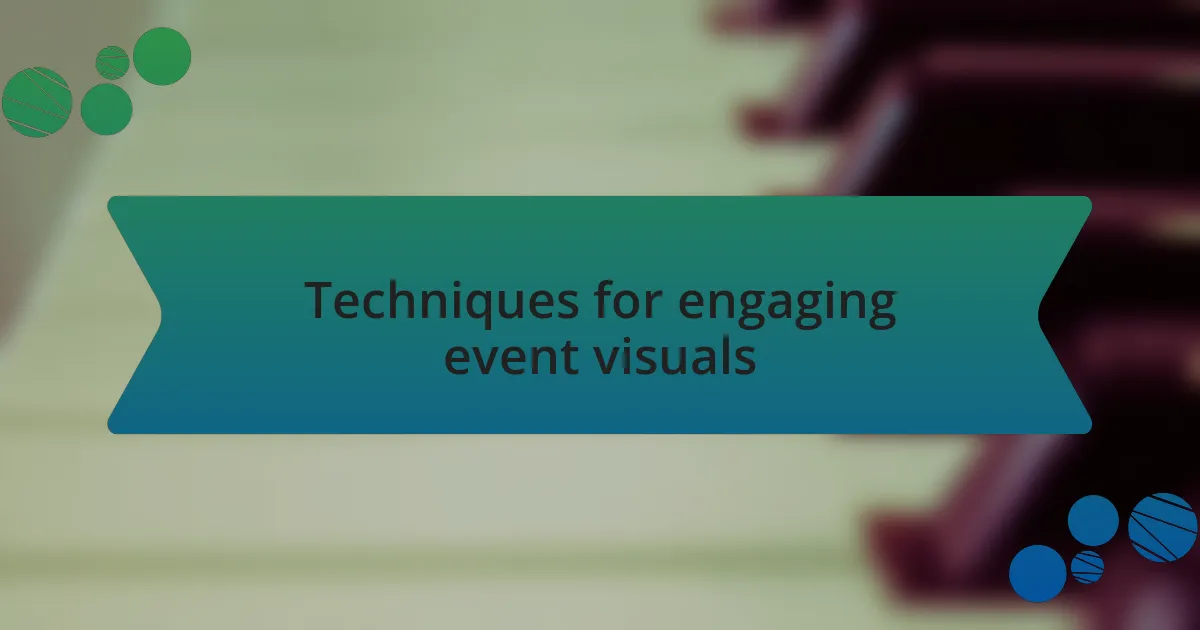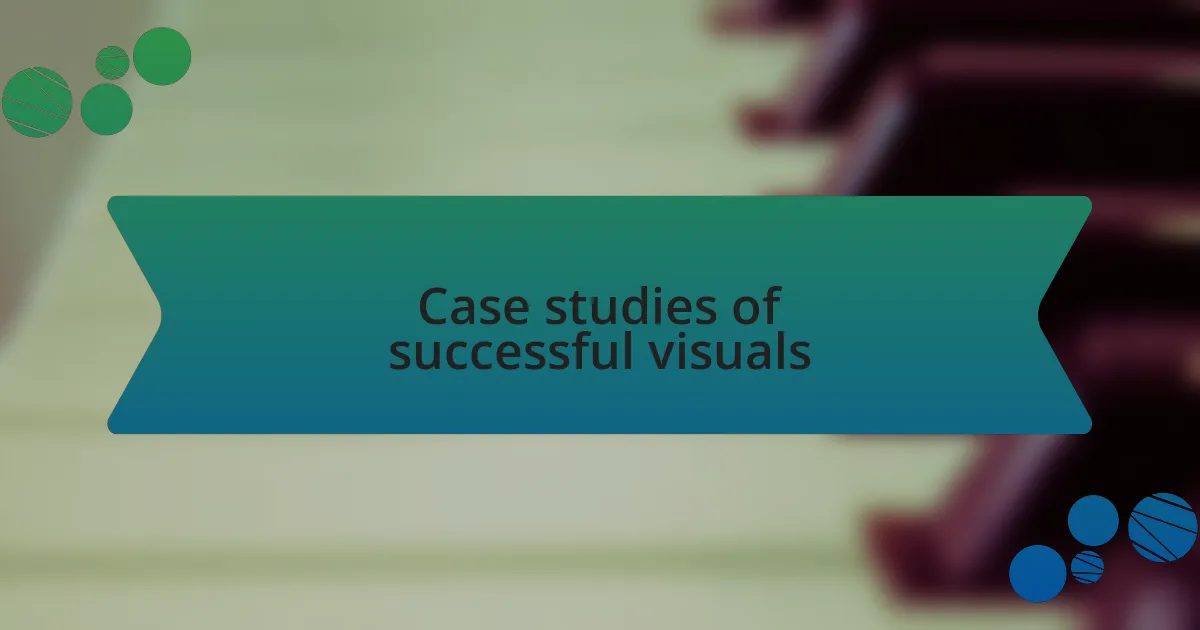Key takeaways:
- Visual narratives enhance audience connection and create unforgettable experiences by syncing visuals with music.
- Key elements of strong visual storytelling include color, imagery, and the relationship between visuals and sound, leading to an engaging atmosphere.
- Techniques like movement, layering visuals, and audience interaction foster deeper engagement and community during events.
- Collaboration with artists and adaptability of visuals are crucial for creating compelling narratives that resonate with the audience’s emotional journey.

Understanding visual narratives for events
Visual narratives for events are essential because they guide the audience’s experience and connection to the music being played. I often think back to a specific event where the lighting synced perfectly with the beats, transforming the atmosphere. It felt like every person in that room was on the same emotional journey, and that’s the power of a visual narrative—it can elevate the music and create unforgettable moments.
Have you ever considered how visuals communicate the story behind the event? For instance, at a recent festival, the projection art told tales of the artists’ journeys, resonating deeply with attendees. It was fascinating to watch people interact with the visuals, often pausing to capture moments on their phones. This interaction shows how a strong visual narrative not only complements but can also enrich the overall experience, creating layers of meaning and engagement.
Creating a visual narrative involves careful thought about how each element fits together. I remember feeling an adrenaline rush during the planning of an event where we incorporated elements like color and imagery deliberately chosen to reflect the vibe of the artists. When every detail resonates with the audience, it becomes a powerful tool for fostering a deeper connection. Isn’t that what we aim for in every event we produce?

Elements of strong visual storytelling
One of the key elements of strong visual storytelling is the use of color. In my experience, colors evoke specific emotions and set the tone for the event. I remember a night when we chose a deep violet palette for an atmospheric deep house set, and the energy in the room transformed instantly. The colors not only reflected the music but also created an inviting vibe that encouraged attendees to lose themselves in the moment.
Imagery is another crucial factor that can communicate the essence of the event. I once collaborated on a festival where we used large-scale visuals that depicted the artists’ backgrounds, weaving a rich tapestry of their journeys. Watching the audience connect with these images was powerful; it brought a sense of unity and understanding, making the music feel even more personal. Have you ever noticed how certain images stick in your mind long after an event has ended? That’s the magic of effective visuals.
Lastly, the relationship between visuals and sound is vital. Synchronizing visual elements with beats or melodic transitions can elevate the experience. I recall a set where we timed bursts of light to the drops in the music, and the crowd reacted in unison—a wave of energy pulsed through the space. When visuals and audio align seamlessly, it creates a captivating synergy that leaves a lasting impression on everyone involved. How do you think this connection influences a person’s memory of an event?

Techniques for engaging event visuals
Creating engaging visuals for events really hinges on the strategic use of movement. I’ve experimented with kinetic visuals, like flowing animations that moved in sync with the rhythm of the music. I remember a particular electronic event where swirling patterns painted the backdrop, dynamically shifting with the beats. It wasn’t just a visual feast; it was like the audience was drawn into an immersive experience that made them feel part of something greater. Have you ever felt the thrill of being enveloped by visuals that seem to dance just for you?
Another technique I find incredibly impactful is layering visuals. Combining different media—like video clips, graphics, and text—can create depth and intrigue. One memorable experience was during an open-air gig, where we projected ethereal landscapes alongside artist performances. The layered visuals encouraged attendees to explore and interpret the imagery themselves, fostering personal connections to the music. Isn’t it fascinating how layered storytelling can spark individual interpretations among a crowd?
Lastly, incorporating audience interaction into the visuals can transform the event atmosphere. At a recent festival, we set up interactive stations where attendees could contribute their own visual content, which we then blended into the main backdrop. Witnessing the excitement on their faces as their contributions lit up the screen was a highlight. This kind of engagement not only made the visuals more dynamic but also fostered a sense of community. How often do we see audiences not just as spectators, but as integral parts of the visual narrative?

Tools for creating event visuals
Creating compelling visuals for events often starts with the right tools. I’ve found that software like Adobe After Effects offers incredible flexibility for crafting complex animation and motion graphics, allowing me to design visuals that resonate with the electronic music vibe. I recall a project where I used After Effects to create a pulsating light show that synchronized perfectly with the bass drops; the effect was electrifying, not just for me but for the entire audience. Have you ever felt the atmosphere shift as the visuals sync with the music?
Another tool I regularly turn to is Resolume, which serves as a powerful VJing software. Its real-time video mixing capabilities enable me to layer visuals live, adjusting to the energy of the crowd in an instant. I still remember the adrenaline rush during a live set, where I seamlessly blended multiple video sources, each shift eliciting cheers from the audience. Isn’t it thrilling to feel the pulse of the crowd rise and fall with your every visual choice?
I must also mention platforms like Canva for creating promotional assets that build excitement before the event. While it’s more straightforward, I’ve managed to design eye-catching flyers and social media visuals that capture the essence of each event. One time, a simple flyer I crafted went viral online, driving up ticket sales significantly. How often do you overlook the importance of visuals in building anticipation?

My approach to visual narratives
My approach to visual narratives is rooted in understanding the emotional beats of music and how visuals can amplify those feelings. When I attend events myself, I pay close attention to the emotional journey, so I can recreate that experience for others. For instance, I often pull inspiration from the way certain colors and movements evoke specific reactions, and I find this to be a powerful tool in storytelling. Have you ever noticed how a simple change in lighting intensity can shift the mood entirely?
Collaboration is also crucial in shaping a strong visual narrative. By working closely with artists and DJs, I gain insights into their vision, allowing me to weave their energy and aesthetic into the visuals. There was a memorable project where I collaborated with a local DJ who wanted a retro-futuristic theme. It was exhilarating to sense their passion, which fueled my creativity; together, we crafted visuals that not only matched the music but also told a story of nostalgia and innovation. Don’t you think that collaborating can elevate the final outcome to something unexpected?
Lastly, I always strive for adaptability in my visual narratives. Each event has its unique vibe, and I relish the challenge of adjusting my visuals on the fly. I remember one occasion where the crowd’s energy took an unexpected turn, and I quickly pivoted to match their intensity. That moment reminded me how crucial it is to stay attuned to the audience; it’s rewarding when my visuals can evolve alongside the atmosphere. Isn’t it exciting to be part of a living, breathing event where visuals and music blend into a shared experience?

Case studies of successful visuals
One memorable example of successful visuals that I think about often was a festival where we used immersive projections to tell a story about the journey of sound. As the beat dropped, waves of visuals adapted in real-time, shifting from tranquil scenes to explosive bursts of color. The connection between the audience and projected imagery was electric—everyone felt like they were part of a shared narrative. Have you ever been in a crowd that felt completely united by a visual spectacle?
Another case that stands out was a club night themed around the concept of shadow and light, where shadows moved rhythmically with the music. We created dynamic visuals that seemed to dance alongside the DJ, enhancing the overall experience. I’ll never forget watching a group of friends lose themselves in the atmosphere, their laughter and energy in sync with the changing visuals. Isn’t it fascinating how visuals can create such a visceral connection among strangers?
Lastly, I think about a recent collaboration where we used augmented reality elements that allowed attendees to interact with the visuals through their smartphones. This innovation brought a level of engagement that transformed passive viewers into active participants. I was thrilled to see faces light up as they discovered hidden layers in the visuals that changed with their movement. Have you experienced that sense of wonder when something unexpected creates a more intimate connection to the performance?